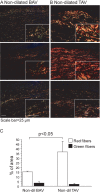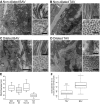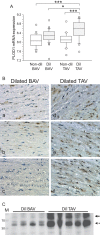Impaired collagen biosynthesis and cross-linking in aorta of patients with bicuspid aortic valve
- PMID: 23525417
- PMCID: PMC3603268
- DOI: 10.1161/JAHA.112.000034
Impaired collagen biosynthesis and cross-linking in aorta of patients with bicuspid aortic valve
Abstract
Background: Patients with bicuspid aortic valve (BAV) have an increased risk of developing ascending aortic aneurysm. In the present study, collagen homeostasis in nondilated and dilated aorta segments from patients with BAV was studied, with normal and dilated aortas from tricuspid aortic valve (TAV) patients as reference.
Methods and results: Ascending aortas from 56 patients were used for biochemical and morphological analyses of collagen. mRNA expression was analyzed in 109 patients. Collagen turnover rates were similar in nondilated and dilated aortas of BAV patients, showing that aneurysmal formation in BAV is, in contrast to TAV, not associated with an increased collagen turnover. However, BAV in general was associated with an increased aortic collagen turnover compared with nondilated aortas of TAV patients. Importantly, the ratio of hydroxylysyl pyridinoline (HP) to lysyl pyridinoline (LP), 2 distinct forms of collagen cross-linking, was lower in dilated aortas from patients with BAV, which suggests that BAV is associated with a defect in the posttranslational collagen modification. This suggests a deficiency at the level of lysyl hydroxylase (PLOD1), which was confirmed by mRNA and protein analyses that showed reduced PLOD1 expression but normal lysyl oxidase expression in dilated aortas from patients with BAV. This suggests that impaired collagen cross-linking in BAV patients may be attributed to changes in the expression and/or activity of PLOD1.
Conclusions: Our results demonstrate an impaired biosynthesis and posttranslational modification of collagen in aortas of patients with BAV, which may explain the increased aortic aneurysm formation in BAV patients.
Figures








References
-
- Fedak PW, David TE, Borger M, Verma S, Butany J, Weisel RD. Bicuspid aortic valve disease: recent insights in pathophysiology and treatment. Expert Rev Cardiovasc Ther. 2005; 3:295-308 - PubMed
-
- Yasuda H, Nakatani S, Stugaard M, Tsujita‐Kuroda Y, Bando K, Kobayashi J, Yamagishi M, Kitakaze M, Kitamura S, Miyatake K. Failure to prevent progressive dilation of ascending aorta by aortic valve replacement in patients with bicuspid aortic valve: comparison with tricuspid aortic valve. Circulation. 2003; 108suppl 1:II291-II294 - PubMed
-
- Nkomo VT, Enriquez‐Sarano M, Ammash NM, Melton LJ, III, Bailey KR, Desjardins V, Horn RA, Tajik AJ. Bicuspid aortic valve associated with aortic dilatation: a community‐based study. Arterioscler Thromb Vasc Biol. 2003; 23:351-356 - PubMed
-
- Nistri S, Sorbo MD, Basso C, Thiene G. Bicuspid aortic valve: abnormal aortic elastic properties. J Heart Valve Dis. 2002; 11:369-373‐ - PubMed
Publication types
MeSH terms
Substances
LinkOut - more resources
Full Text Sources
Other Literature Sources
Medical
Research Materials
Miscellaneous

